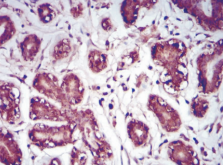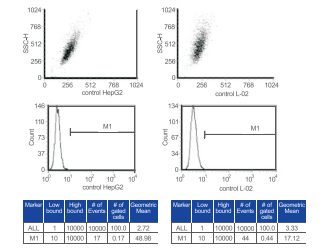Description
Mouse Anti S-AdenosylMethionine (SAM) Clone 118-6 | MA00201 | Arthus Biosystems
Product name
Mouse anti-SAM la/b
Catalog Number
MA00201-50/100
Description
Mouse monoclonal antibody to S-Adenosylmethionine [118-6]
Specificity
Dosage-dependent competition was detected as a sample was added to a cELISA ( Any SAM from a sample competes with the coated SAM heptan to bind HRP-conjugated antibody 118-6 ) . The sample is the product of the following biochemical reaction: Methionine Adenosyltransferase ( MAT ) was added to methionine and adenosine triphosphate under an appropriate buffer at 37°C. It indicates that antibody 118-6 specifically binds physiologically produced SAM.
Cross Reaction
MA00201 shows the following reactivity with related compounds: S-Adenosylmethionine: 100%, S-Adenosylhomocysteine: < 1%, Adenosine: < 1%, L-Methionine: < 1%, Methythioadenosine ( MTA ) : < 1%, ADP ( adenosine diphosphate ) < 1%, ATP ( adenosine triphosphate ) < 1%
Immunogen
S-Adenosylmethionine analog conjugated to KLH
Properties
Form
Liquid
Storage instructions
Store at 4°C, -20°C for long term storage
Storage buffer
PBS 10mM pH7.4 (NaCI 150mM), Sodium azide 0.02%, BSA 10mg/m1 or PBS 10mM, pH7.4 (NaCI 150mM), Sodium azide 0.02%, Glycerol 50%, BSA 10mg/m1
Purity
>95% Purified from mouse ascites fluid by affinity chromatography
Clonality
Monoclonal
Clone number
118-6
Immunoglobin isotype
IgG2b
Affinity
Ka = 5.75 x 109L/mol (1.74 x 10-19M)
Research Areas
- Methylation of biomolecules (DNA, RNA, proteins, hormones, neurotransmitters, etc.)
- One-carbon metabolism
- Signal Transduction
- Metabolism
- Pathways and Processes Cancers
- Arthritis
- Heart diseases
- Neurodegenerative diseases
- Atherosclerosis
- Liver diseases
- Kidney diseases
Applications
The use of MA00201 in the following tested applications has been tested. The application notes include recommended starting dilutions. Optimal dilutions/concentrations should be determined by the end user. Higher dilution than suggested maybe used in IHC and IF. The product may be used in other not-yet-tested applications.
Notes
- cELISA: 1:10,000-1:30,000
- FCM: 1:200/400
- IHC: 1:200/400
Target
S- Adenosylmethionine is a common co-substrate involved in methyl group transfers. It is made from adenosine triphosphate (ATP) and methionine by methionine adenosyltransferase. Transmethylation, transsulfuration, and aminopropylation are the metabolic pathways that use SAM. Although these anabolic reactions occur throughout the body, most SAM is produced and consumed in the liver.
Cellular localization
Cytoplasm, nuclear

Figure 1: Competitive ELISA using anti-S-Adenosymethionine monoclonal antibody [118-6] (MA00201) The 0.1 pg/ml of SAM coating standard (Cat # ACT00201) was coated into 96 wells. Serial dilution of SAM standard (Cat # AST00201),S-Adenosylhomocysteine(SAH), Adenosine (Ade), L-Methionine (Met), Methythioadenosine (MTA), Adenosine diphosphate (ADP), Adenosine triphosphate (ATP) and 1:35000 of MA00201 were added. HRP conjugated Goat anti-Mouse IgG antibody was used to develop the color. The A is the OD450 value of the test well and the AO is the OD450 of the well without competitive antigen.

Figure 2: Immunohistochemistry staining was performed using MA00201 with benign breast tissue adjacent to carcinoma. Brown areas indicated strong positive staining in nuclear and cytoplasmic areas.

Figure 3: The same samples as in Figure 2 from breast cancer area.Cytoplasmic and nuclear areas showed negative or much weak or background staining.

Figure 4: FCM analysis control. Normal liver cells L02 and carcinoma cells Hep G2 were stained with the buffer without any antibody.

Figure 5: FCM results from normal liver cell line L02 and hepatocyte carcinoma cell line Hep G2 stained with anti-SAM monoclonal antibody from clone 118-6.Average fluorescence signal in Hep G2 cells was reduced compared to that in L02 cells, indicating SAM level is reduced during carcinogenesis.






